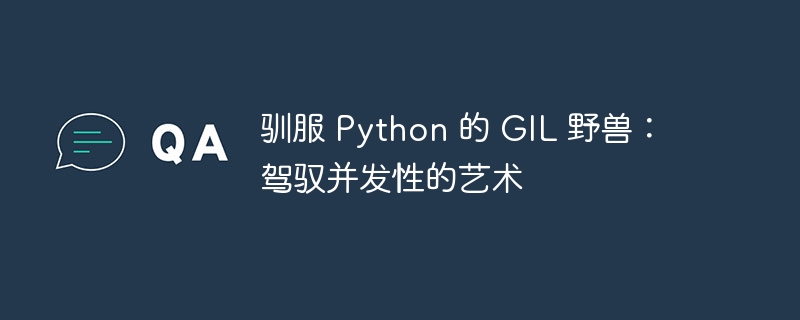Home >Backend Development >Python Tutorial >Taming Python's GIL Beast: The Art of Mastering Concurrency
Taming Python's GIL Beast: The Art of Mastering Concurrency
- 王林forward
- 2024-03-02 16:28:211298browse

python, GIL, Concurrency, Multi-threading, Multi-process
Python's Global Interpreter Lock (GIL) is a built-in mechanism that ensures that only one thread can execute Python bytecode at a time. This lock is to prevent data corruption because it prevents multiple threads from modifying shared data at the same time.
Limitations of GIL
While the GIL is critical for ensuring data integrity, it also imposes significant limitations on Python's concurrency:
- Sequentiality: GIL forces all threads to execute sequentially, limiting the parallelism of Python concurrent programs.
- Bottleneck: When one thread is waiting in an I/O operation or other blocking operation, the GIL prevents other threads from executing. This can cause task delays and performance degradation.
Overcoming GIL limitations
While the GIL cannot be completely bypassed, there are techniques to mitigate its impact on concurrency:
1. Multi-process
Multiple processes use multipleoperating system processes instead of Python threads to achieve concurrency. Since each process has its own GIL, they can execute simultaneously without any lock contention:
import multiprocessing
def task(num):
print(f"Process {num}: {num * num}")
if __name__ == "__main__":
processes = [multiprocessing.Process(target=task, args=(i,)) for i in range(4)]
for process in processes:
process.start()
for process in processes:
process.join()
2. Multithreading and Queue
Using multiple threads and queues can achieve parallelism while avoiding GIL contention. Threads put tasks into a queue, while other threads get tasks from the queue and execute them:
import threading
import queue
queue = queue.Queue()
def producer():
for i in range(10):
queue.put(i)
def consumer():
while not queue.empty():
item = queue.get()
print(f"Thread: {item * item}")
threads = [threading.Thread(target=producer), threading.Thread(target=consumer)]
for thread in threads:
thread.start()
for thread in threads:
thread.join()
3. Greenlets
Greenlets are coroutines, they allow you to pause and resume functions within a single thread. Because Greenlets are not bound by the GIL, they can achieve concurrency without lock contention:
import gevent
def task(num):
print(f"Greenlet {num}: {num * num}")
gevent.joinall([gevent.spawn(task, i) for i in range(4)])
4. C/C extension
For concurrent applications that require high performance,C/C extensions can be written and integrated with Python. C/c Code is not affected by the GIL and therefore provides faster parallelism:
#include <Python.h>
static PyObject* py_task(PyObject* self, PyObject* args) {
int num;
if (!PyArg_ParseTuple(args, "i", &num)) {
return NULL;
}
// 执行任务
int result = num * num;
return Py_BuildValue("i", result);
}
static PyMethodDef methods[] = {
{"task", py_task, METH_VARARGS, "PerfORM a task in a C extension"},
{NULL, NULL, 0, NULL}
};
static PyModuleDef module = {
PyModuleDef_HEAD_INIT,
"c_extension",
"C extension for parallel task execution",
-1,
methods
};
PyMODINIT_FUNC PyInit_c_extension(void) {
return PyModule_Create(&module);
}
Summarize
While Python’s GIL is critical for ensuring data integrity, it limits concurrency. By employing strategies such as multiprocessing, multithreading and queues, Greenlets, or C/C extensions, you can overcome the limitations of the GIL and unlock the full potential of Python concurrency. However, when using these technologies, their advantages, disadvantages, and suitability need to be carefully considered.The above is the detailed content of Taming Python's GIL Beast: The Art of Mastering Concurrency. For more information, please follow other related articles on the PHP Chinese website!

